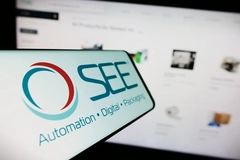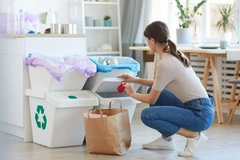P&G’s Herbal Essences hair care bottles aid visually impaired consumers with lasered markers
07 Jul 2021 --- Domino Printing Sciences has teamed up with Procter and Gamble (P&G) to help visually impaired consumers distinguish hair care products with tactile bottle markers. Domino’s D-Series CO2 laser coders are used to create the markers.
“The chosen design features a row of raised lines on the bottom of the back of the shampoo bottles – ‘S’ for shampoo, ‘S’ for stripes – with two rows of raised dots in the same place on conditioner bottles – ‘C’ for conditioner, ‘C’ for circles,” explains Dr. Stefan Stadler, team lead at Domino’s Laser Academy.
“We realized that we have a huge opportunity to improve our products and packaging and encourage other businesses to do the same,” says P&G’s special consultant for inclusive design, Sumaira Latif, who is registered blind herself.
She notes the designs are “nothing that should inconvenience hair care product companies into spending a lot of extra money, and make them have to jack up the price.”
Privacy please
Even for visually impaired consumers with some sight, it can be difficult to identify products while in the shower or bath, where sight aids, such as glasses, contact lenses or magnifiers, are not typically used.
Domino’s D-Series CO2 laser coders create the vertical line and circle tactile markers.“Most shampoo and conditioner bottles are designed to look and feel the same. It may seem like a small thing, but there are hundreds of these little things that visually impaired people like myself have to spend time checking and rechecking each day,” continues Latif.
“If you want to be independent, if you want to be confident, you don’t want to be asking your brother, your mother, your sister, your husband, your children ‘What bottle is this?’ especially in such a private location as a shower.”
Finding the right spot
From their conception, the markers could not compromise bottle integrity, as they have to look aesthetically pleasing on-shelf and stay durable throughout the product’s life.
“The initial brief from P&G was for coding the bottles with triangle, circle and square symbols,” says Stadler. However, initial testing revealed these symbols would be difficult to distinguish by touch.
The Laser team identified the bottle’s bottom, where the plastic is at its thickest, as the best location for the tactile labeling, where it would be easily identifiable without compromising the packaging’s integrity.
In initial sample tests, Domino’s D-Series CO2 Laser coders managed to etch the required vertical line and circle markers, leaving a tactile mark without compromising the substrate.
“We discovered that laser absorption at the tested wavelengths is independent of bottle color,” says Stadler. “The same solution could be replicated using different colored PET, which means that a wide range of product brands could adopt.”
The stripes on-pack stand for the “S” in the word shampoo.Bailing on Braille
Despite Braille being a well-known tactile communication method, P&G decided against it. According to The National Federation of the Blind, less than 10 percent of US people registered as legally blind can read the tactile writing system. Moreover, only 10 percent of blind children are learning to read Braille.
“Most people with visual impairments cannot read Braille – it takes months, if not years to learn, and really you have to start young to develop the sensitivity. Most people develop visual impairments in later life, when Braille is no longer an option,” says Latif.
P&G and Domino instead sought to develop a “more universal alternative” that could make the bottles more accessible to anyone with partial or complete sight loss.
To ensure the new stripes and circles approach would work for consumers, P&G presented the newly-coded Herbal Essences bio:renew bottles to the Royal National Institute of Blind People (RNIB) for UK consumer testing.
The circular dots on the back of the bottle illustrate the letter “C” in conditioners.A follow-up focus group with visually impaired consumers “overwhelmingly approved” of the new inclusive bottle design, says Domino.
Packaging for the visually impaired
Inclusive packaging is a relatively untapped market. However, innovation in this space ranges from QR codes on olive oil bottles to embossing fixtures for luxury packaging.
The personal care sector in particular is making advances toward more inclusive packaging. In 2019, Herbal Essences introduced technology like Alexa and the Be My Eyes app to make its products more accessible to people with little to no vision.
In a major design overhaul, Unilever’s deodorant brand Degree developed an antiperspirant for people with visual impairment and upper limb motor disabilities. The new deodorant bottle hangs by an easily detachable hook lid for one-handed use. Magnetic closures further facilitate taking the cap off and putting it back on.
By Anni Schleicher












